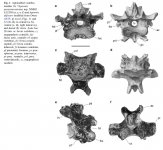Some details:
Trevor H. Worthy • Alan J. D. Tennyson • R. Paul Scofield, 2011
Fossils reveal an early Miocene presence of the aberrant gruiform
Aves: Aptornithidae in New Zealand
Journal of Ornithology July 2011, Volume 152, Issue 3, pp 669–680
Abstract:
A member of the New Zealand endemic family (Aves: Aptornithidae) is described from the Early Miocene St Bathans Fauna of Central Otago, South Island, New Zealand. The new species, based on two thoracic vertebrae, is provisionally referred to the highly distinctive Late Pleistocene–Holocene extinct genus
Aptornis Mantell, 1848 (in Quart J Geol Soc Lond 4:225–238, 1848). It differs from both Recent species by slightly smaller size, greater pneumaticity of the corpus vertebrae and differences of the processus spinosus and processus transversi. We refer a distal femur, another vertebral fragment, a phalange and tentatively a tibial fragment, also from the St Bathans Fauna, to this new taxon.
Systematic palaeontology
Family Aptornithidae Bonaparte, 1856
Genus
Aptornis Mantell, 1848
?Aptornis proasciarostratus sp. nov.
Holotype: NMNZ S.52350, vertebra 16, collected 11 February 2009 by the University of New South Wales, NSW, Australia/CM /NMNZ expedition.
Etymology: From pro, before, ascia, Latin for adze, and rostratus, Latin adjective for beaked, in deference to the common name adzebill, derived from Parker’s (1866) referral to this bird as the ‘adze-headed bird’.
Type locality: Bed HH1a, Manuherikia River, Otago.
Stratigraphy/age/fauna: Manuherikia Group, Early Miocene (Altonian); 19–16 Ma; St Bathans Fauna.
Paratype: NMNZ S.52353, vertebra 19, lacking proc. transversus and proc. spinosus, collected 2 March 2010 from bed HH1b, Trench Excavation, Manuherikia River, Otago.
Referred specimens: NMNZ S.50961, a poorly preserved centrum of a dorsal vertebra from the HH1b Trench; OU22647, distal right femur, collected in the Manuherikia River Section just above Bed HH1b near the river bank (approx. 9.50–9.58 m above the base of Bannockburn Formation), by Alexander Fergus in March 2005; NMNZ S.42623 phalanx right IV.1 (Worthy et al. 2007), and a tibiotarsal fragment NMNZ S.50191, from the HH1b Trench, both of appropriate size and shape for this new taxon.
Fred







